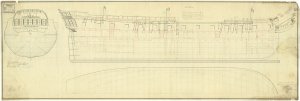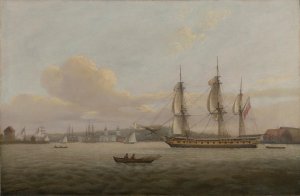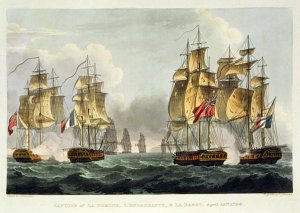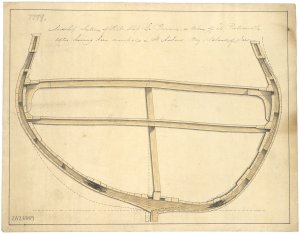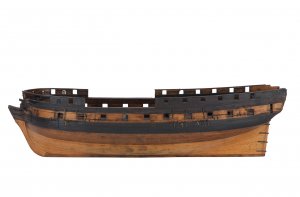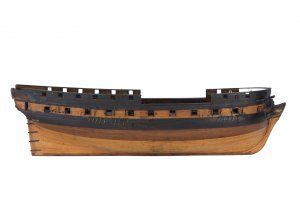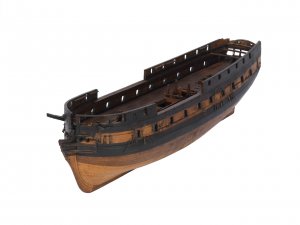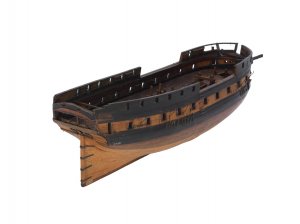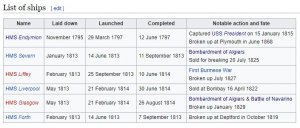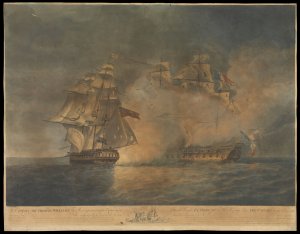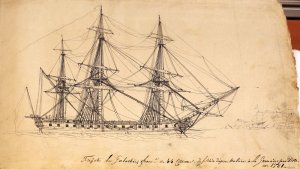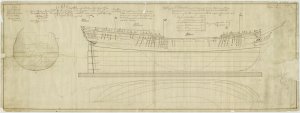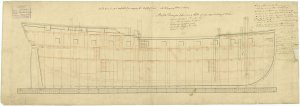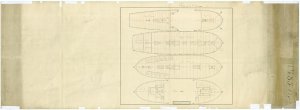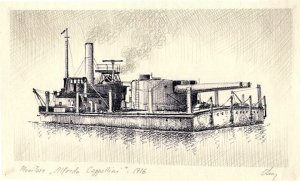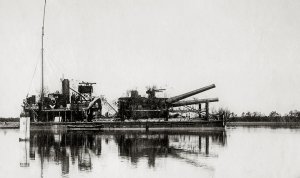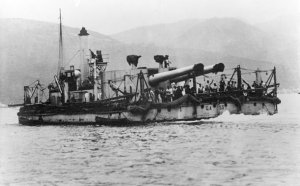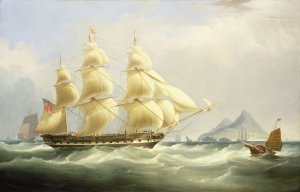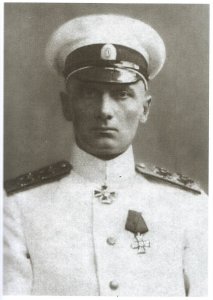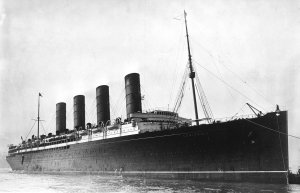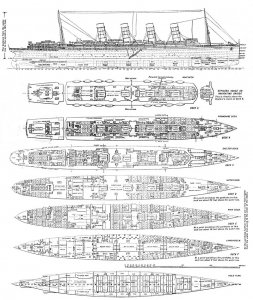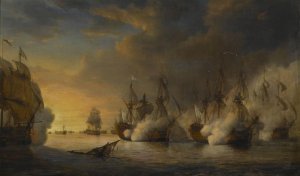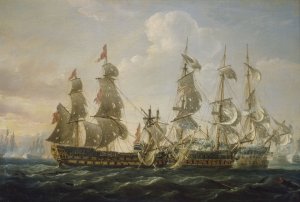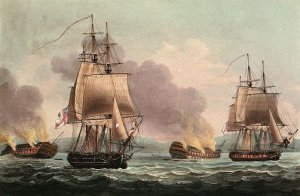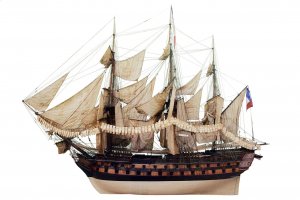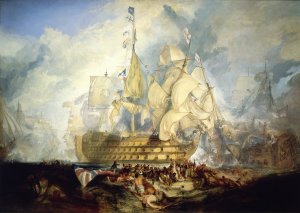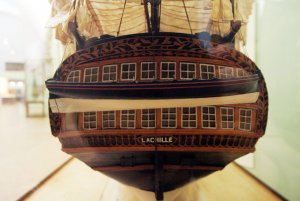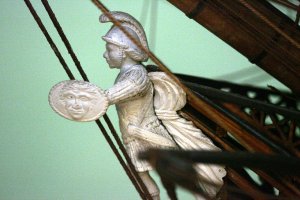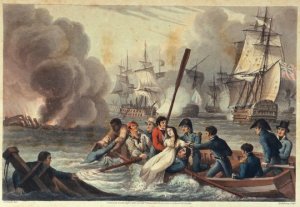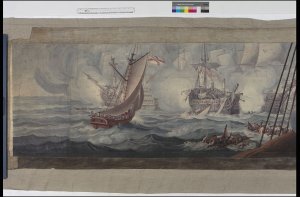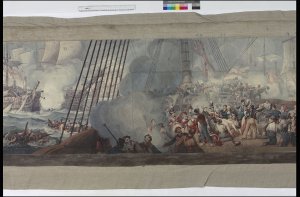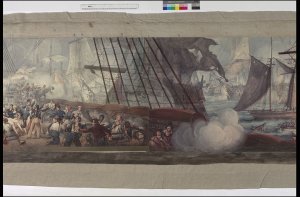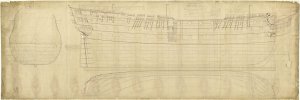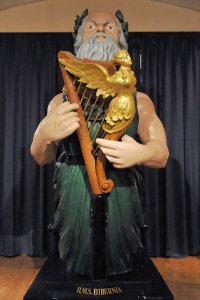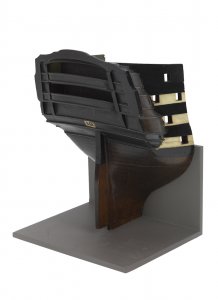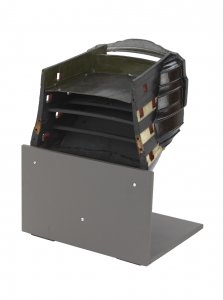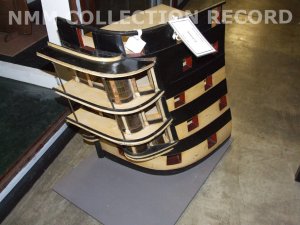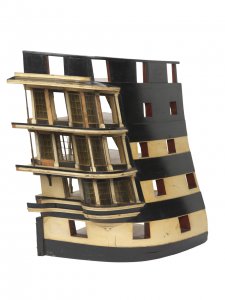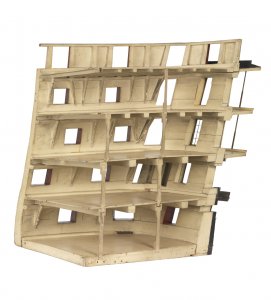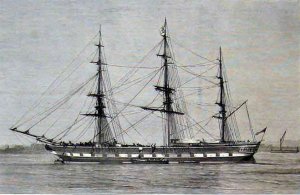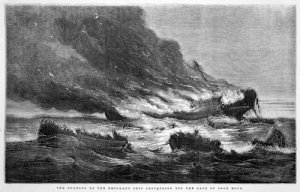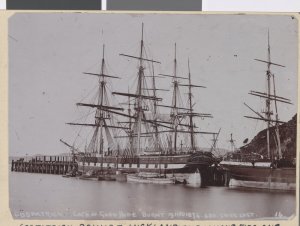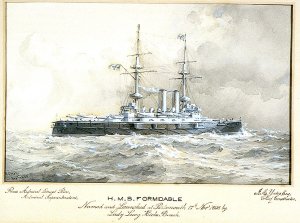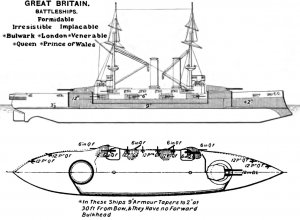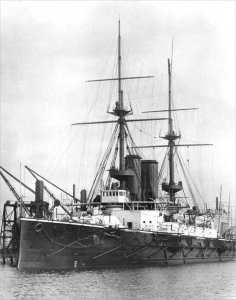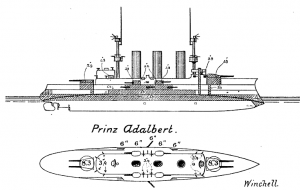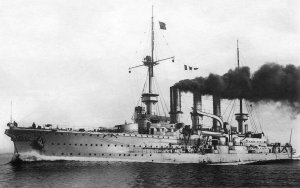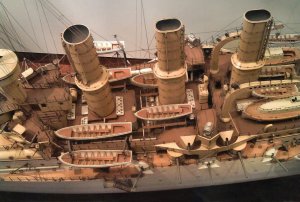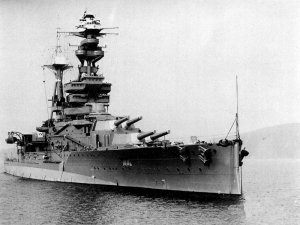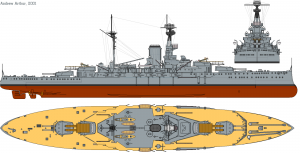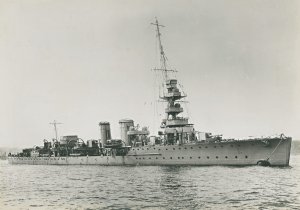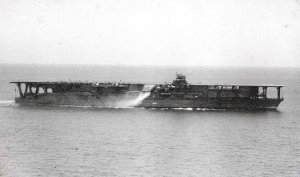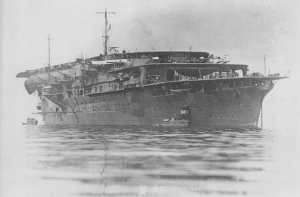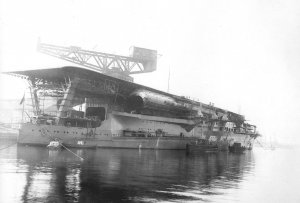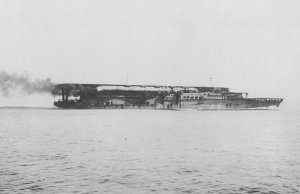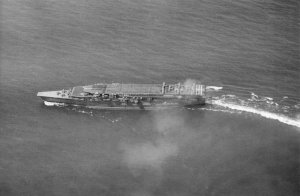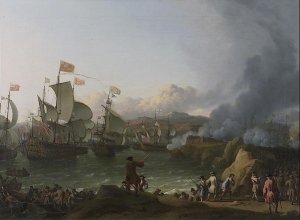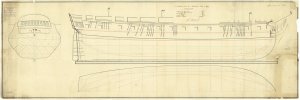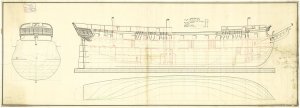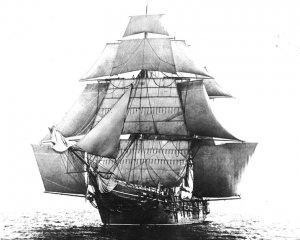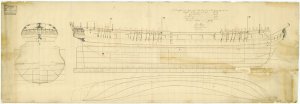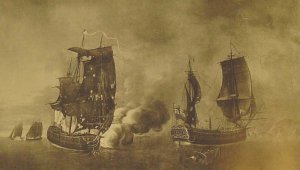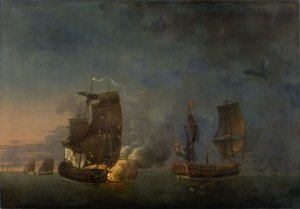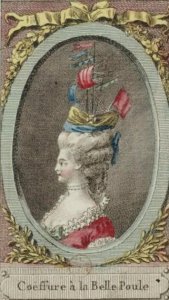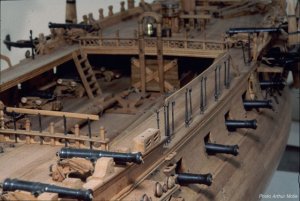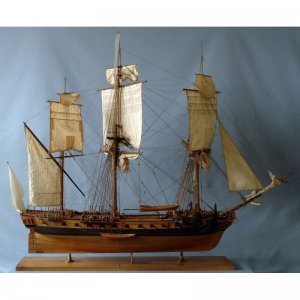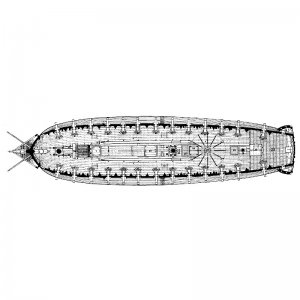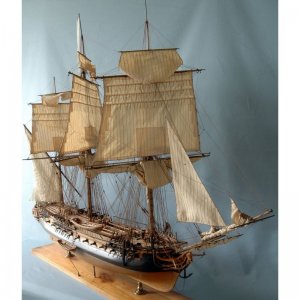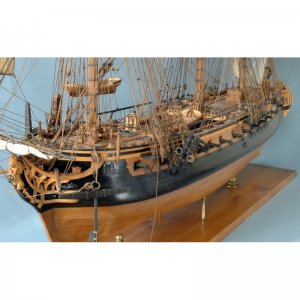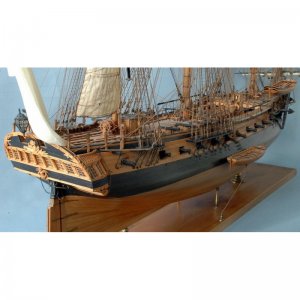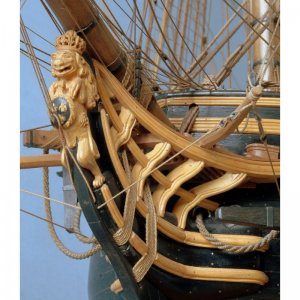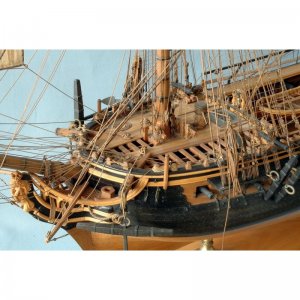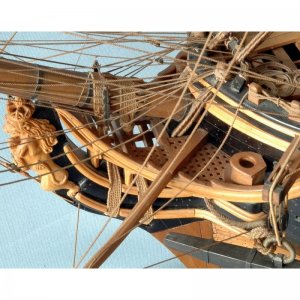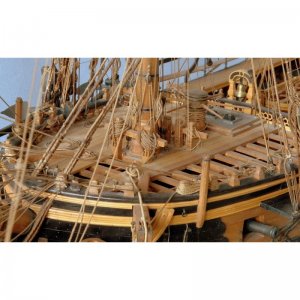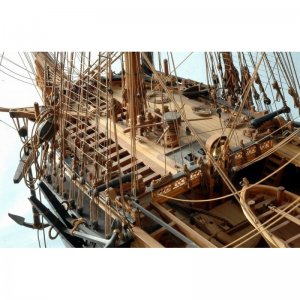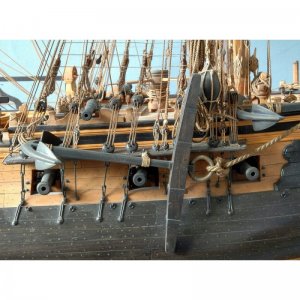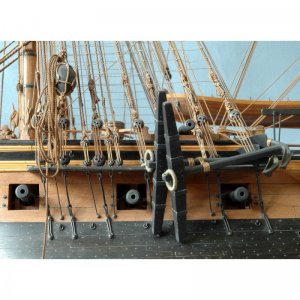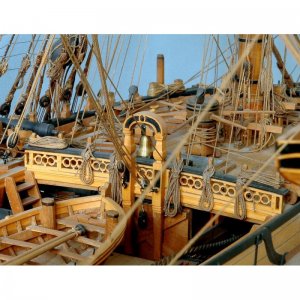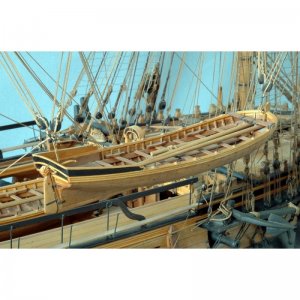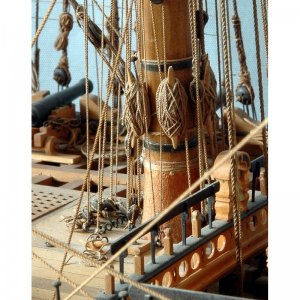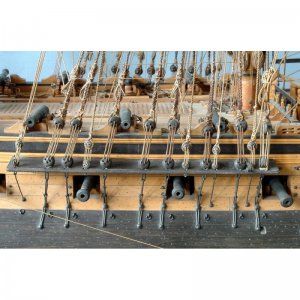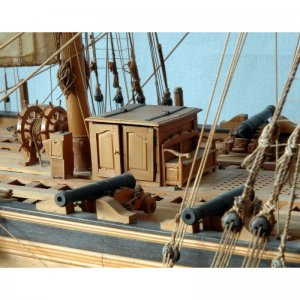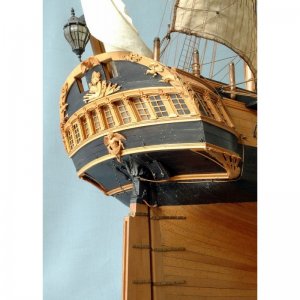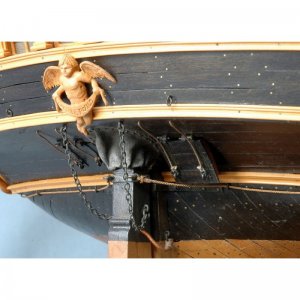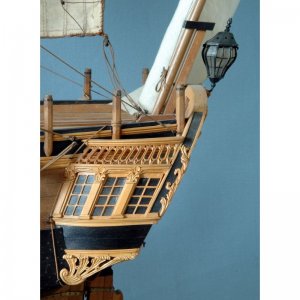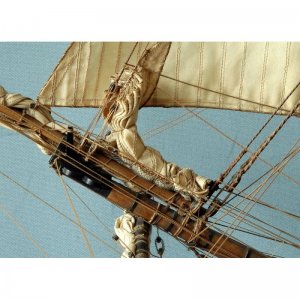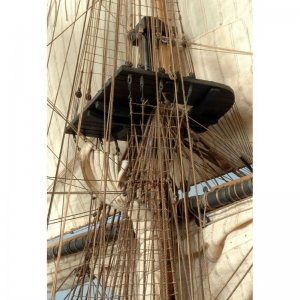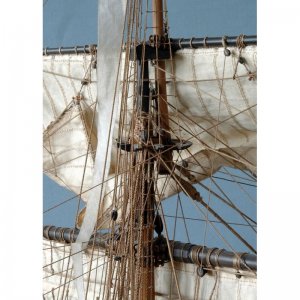Today in Naval History - Naval / Maritime Events in History
16 November 1776 - The first salute of an American flag (Grand Union Flag) by a foreign power is rendered by the Dutch at St. Eustatius, West Indies in reply to a salute by the Continental ship Andrew Doria.
The dutch island Sint Eustatius sold arms and ammunition to anyone willing to pay. It was one of the few places from which the young United States could obtain military stores. The good relationship between St. Eustatius and the United States resulted in the noted "First Salute".
Sint Eustatius (Dutch pronunciation: [sɪnt øːˈstaːtsijʏs]), also known affectionately to the locals as Statia (/ˈsteɪʃə/), is an island in the Caribbean. It is a special municipality (officially “public body”) of the Netherlands.
On November 16, 1776, Captain Isaiah Robinson of the 14-gun American brig Andrew Doria, sailed into the anchorage below St. Eustatius' Fort Oranje. Robinson announced his arrival by firing a thirteen gun salute, one gun for each of the thirteen American colonies in rebellion against Britain. Governor Johannes de Graaff replied with an eleven-gun salute from the cannons of Fort Oranje. International protocol required a two gun less acknowledgment of a sovereign flag. The Andrew Doria flew the Continental Colors of the fledgling United States. It was the first international acknowledgment of American independence. The Andrew Doria had arrived to purchase munitions for the American Revolutionary forces. She was also carrying a copy of the Declaration of Independence which was presented to Governor De Graaff. An earlier copy had been captured on the way to Holland by the British. It was wrapped in documents that the British believed to be a strange cipher. In reality the documents were written in Yiddish, to Jewish merchants in Holland.
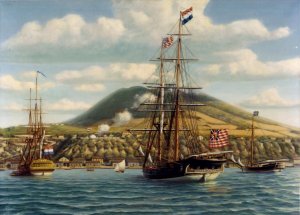
First official salute to the American flag on board an American warship in a foreign port, 16 November 1776. Painting by Phillips Melville, depicting Continental Brig Andrew Doria receiving a salute from the Dutch fort at St. Eustatius, West Indies, 16 November 1776. The artist shows the "Grand Union" flag flying at Andrew Doria 's stern and foremast peak. Courtesy of the U.S. Navy Art Collection, Washington, D.C. Donation of Colonel Phillips Melville, USMC (Retired), 1977.
U.S. President Franklin Delano Roosevelt came to St. Eustatius in 1939 to recognize the importance of the 1776 "First Salute". He presented a large brass plaque to St. Eustatius which is displayed today under a flagpole atop the walls of Fort Oranje. President Roosevelt visited the island for 2 hours on February 27, 1939 on the USS Houston. The plaque reads:
"In commemoration to the salute to the flag of the United States, Fired in this fort November 16. 1776, By order of Johannes de Graaff, Governor of Saint Eustatius, In reply to a National Gun-Salute, Fired by the United States Brig of War Andrew Doria, Under Captain Isaiah Robinson of the Continental Navy, Here the sovereignty of the United States of America was first formally acknowledged to a national vessel by a foreign official. Presented by Franklin Delano Roosevelt, President of the United States of America"
The recognition provided the title for Barbara W. Tuchman's 1988 book The First Salute: A View of the American Revolution.
The British took the incident seriously. Britain protested bitterly against the continuous trade between the United Colonies and St. Eustatius. In 1778, Lord Stormont claimed in Parliament that, "if Sint Eustatius had sunk into the sea three years before, the United Kingdom would already have dealt with George Washington". Nearly half of all American Revolutionary military supplies were obtained through St. Eustatius. Nearly all American communications to Europe first passed through the island. The trade between St. Eustatius and the United States was the main reason for the Fourth Anglo-Dutch War,1780-1784. For example, the British Admiral George Brydges Rodney, having occupied the island for Great Britain in 1781, urged the commander of the landing troops, Major-General Sir John Vaughan, to seize "Mr. Smith at the house of Jones - they (the Jews of St. Eustatius, Caribbean Antilles) cannot be too soon taken care of - they are notorious in the cause of America and France." The war was disastrous for the Dutch economy.
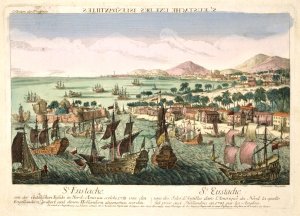
The island of St. Eustatius taken by the English fleet in February 1781. Admiral Rodney's sailors and troops pillaged the island.
Britain declared war on the Republic of the Seven United Netherlands on December 20, 1780. Even before officially declaring war, Britain had outfitted a massive battle fleet to take and destroy the weapons depot and vital commercial center that St. Eustatius had become. British Admiral George Brydges Rodney was appointed the commander of the battle fleet. February 3, 1781, the massive fleet of 15 ships of the line and numerous smaller ships transporting over 3,000 soldiers appeared before St. Eustatius prepared to invade. Governor De Graaff did not know about the declaration of war. Rodney offered De Graaff a bloodless surrender to his superior force. Rodney had over 1,000 cannon to De Graaff's one dozen cannon and a garrison of sixty men. De Graaff surrendered the island, but first he fired two rounds as a show of resistance in honor of Dutch Admiral Lodewijk van Bylandt, who commanded a ship of the Dutch Navy which was in the harbor. Ten months later, the island was conquered by the French, allies of the Dutch in the war. The Dutch regained control over the looted and plundered island in 1784.
At its peak, St. Eustatius may have had a largely transient population of about 10,000 people. Most were engaged in commercial and maritime interests. A census list of 1790 gives a total population (free and enslaved people combined) of 8,124. Commerce revived after the British left. Many of the merchants (including the Jews) returned to the island. However, French and British occupations from 1795 disrupted trade and also the North-Americans, now globally recognised as an independent nation, had meanwhile developed their own trading network and did not need St. Eustatius anymore. The island was eclipsed by other Dutch ports, such as those on the islands of Curaçao and Sint Maarten. During the last years of the 18th century Statia developed trade in bay rum. The economy declined in the early 19th century. From about 1795, the population declined and in 1948 the population stood at a mere 921.
Andrew Doria was a brig purchased by the Continental Congress in November 1775. She is most famous for her participation in the Battle of Nassau—the first amphibious engagement by the Continental Navy and the Continental Marines—and for being the first United States vessel to receive a salute from a foreign power.
Type: Brig
Displacement: 190 long tons (190 t)
Length: 75 ft (23 m)
Beam 25 ft (7.6 m)
Depth: 10 ft (3.0 m)
Complement: 112 officers and men
Armament: 14 × 4-pounder (1.8 kg) guns
Purchase
On 13 October 1775, the Continental Congress authorized the purchase of the merchant brig Defiance. The ship was acquired in mid-November and moored in Wharton and Humphreys shipyard in Philadelphia where she was converted into a warship by Joshua Humphreys (hull strengthening), John Barry (re-rigging), and John Falconer (ordnance and provisioning) at a cost of £296.4s.6d. She was named Andrew Doria after the 16th-century Genoese admiral Andrea Doria. Under the command of Captain Nicholas Biddle, Andrew Doria departed Philadelphia on 4 January 1776, as a warship in Esek Hopkins' small fleet of five newly fitted warships (Alfred, Andrew Doria, Cabot, Columbus, and Providence), bound for the Chesapeake Bay. Between 11 and 17 February, the fleet was joined by the small sloop Fly, the sloop Hornet, and the schooner Wasp.
Battle of Nassau
Main article: Battle of Nassau
On 17 February 1776, Hopkins decided to take advantage of the discretion offered him and skip his missions in the Chesapeake Bay and along the coasts of the Carolinas. Instead, he took the fleet to the Bahamas for a raid on the island of New Providence to seize a large supply of gunpowder reportedly stored in the two forts that protected Nassau. On 1 March, the fleet reached the coast of Abaco Island where the ship Alfred captured two small sloops and Hopkins obtained intelligence from the prisoners that New Providence lay undefended. Hopkins planned to take Nassau by frontal assault, slipping his landing party of 270 sailors and marines into the harbor hidden on board the captured sloops. It was hoped that the American troops would not be detected until the landing and assault on Fort Nassau began. Success in this endeavor would enable the fleet to enter the harbor while the fort's guns, then in American hands, held the town at bay.
The marines and sailors embarked on the two captured sloops on the evening of 2 March and headed for New Providence, hoping to arrive at daybreak. While following the sloops, the fleet attempted to remain out of sight until the landing party had secured the fort. Andrew Doria—popularly referred to as the "Black Brig"—outdistanced her consorts and found it necessary to lay-to until the other American warships caught up. As the troop-carrying sloops headed into the harbor, Fort Nassau's guns opened fire. The shot fell short but demonstrated that the American fleet had been detected and that its intentions had been surmised. Hopkins recalled his ships.
After conferring with his officers, Hopkins decided to land his troops two miles (3 km) down the coast from Fort Montagu, which protected the eastern approaches to Nassau. The marines and sailors went ashore on 3 March and marched to Fort Montagu whose garrison surrendered without offering any real resistance. On 4 March, the Americans took Fort Nassau and town of Nassau. The fleet remained for almost two weeks, dismantling the guns of the forts and loading the captured materiel. During this stay, large numbers of the crew of each ship were stricken by a virulent fever. This complicated an already serious health problem caused by an outbreak of smallpox on all of the ships except for Andrew Doria whose crew had been protected by inoculation due to the far-sighted insistence of Nicholas Biddle. As a result of the crew's immunization, Andrew Doria was selected to serve as a hospital ship for the fleet and continued in this role for the remainder of the expedition. On 16 March, Hopkin's fleet departed Nassau and headed north.
Battle of Block Island
Main article: Battle of Block Island
Shortly after midnight on 6 April 1776, a lookout on Andrew Doria sighted two vessels to the southeast. Biddle passed word of the discovery to Hopkins who ordered the fleet to head for the strangers. The larger of the unidentified ships headed toward the Americans and before long she was within hailing distance and identified herself as "... his majesty's ship of war Glasgow...." A broadside from Cabot into the British frigate opened a fierce fight in which the American ships were unable to fight as a squadron. In attempting to avoid a salvo from Glasgow, Cabot crossed Andrew Doria's bow, forcing Biddle's brig onto a port tack which avoided collision but took her away from the action. Meanwhile, Alfred and Columbus, Hopkins' largest warships, took on Glasgow but received worse punishment than they inflicted.
As the crew of Andrew Doria worked the ship into position to reenter the engagement and opened fire, Glasgow's captain realized he was overmatched and decided to stand off to the northward. Andrew Doria, followed at a distance by her consorts, gave chase and kept up a running fight with her bow chasers until recalled by Hopkins, lest Glasgow lead his fleet to a Royal Navy squadron then operating in Rhode Island waters. When the American fleet had reformed, it retired to New London, Connecticut, where it arrived on the morning of 8 April.
Change of command
From 9 April to 17 September 1776, Andrew Doria patrolled the Atlantic coast from Connecticut to Bermuda, capturing a number of British and Loyalist ships. Capt. Biddle anchored his brig at Chester, Pennsylvania, on the evening of 17 September, ending his last cruise on the warship, as he had been selected to command Randolph, one of the four new frigates being built at Philadelphia for the Continental Navy. Capt. Isaiah Robinson took command of Andrew Doria.
First salute

Fort Oranje on the island of Sint Eustatius fired the first salute by a foreign power to Andrew Doria.
See also: "First Salute"
Robinson sailed Andrew Doria down the Delaware River on 17 October 1776, for a voyage to the West Indies to obtain a cargo of munitions and military supplies at the Dutch island of Sint Eustatius. When the brig reached the island on 16 November, she fired a 13-gun salute and received a reply from Fort Oranje—the first salute to an American flag on board an American warship in a foreign port. Andrew Doria also carried a copy of the Declaration of Independence to the island. The so-called "first salute" was widely reported in the United States at the time, and later provided the title for Barbara Tuchman's 1988 book, The First Salute: A View of the American Revolution.
On her way back to the Delaware River, Andrew Doria encountered the sloop HMS Racehorse, of 10 guns, and under the command of Commander James Jones. A two-hour single-ship action ensued before Racehorse struck. Andrew Doria had lost four men killed and eight wounded; casualties on Racehorse apparently were higher. The Andrew Doria encountered a British Snow and assigned Joshua Barney to return the ship to Philadelphia, but was captured with a fouled rudder off Chincoteage by the HMS Perseus (1776). The captain released Barney on pardon in Charleston to return to Philadelphia on foot over 19 days. Andrew Doria returned to Philadelphia where the Continental Navy acquired Racehorse, which it renamed Surprise.
Scuttling
Andrew Doria was stationed in the Delaware River through the spring and summer of 1777. After Vice Admiral Lord Howe brought his British fleet into the river in September 1777, Andrew Doria was part of the forces charged with defending Philadelphia. Following the British occupation of Fort Mifflin on 16 November, Andrew Doria, with the remaining ships of the Continental Navy, sought shelter under the guns of Fort Mercer, at Red Bank, New Jersey. With the evacuation of Fort Mercer on 20 November, Robinson gave orders the next day for the ships to be burned to prevent capture. This was done shortly thereafter.
Replica
The not-for-profit organization Andrew Doria - The First Salute, Inc., is raising funds to build a working replica of Andrew Doria. On 18 May 2009, the city council of Havre de Grace, Maryland, agreed to lease land to the organization for the construction of a shipyard which will be located near the Susquehanna Museum at the Lockhouse on the banks of the Susquehanna River.
https://en.wikipedia.org/wiki/Andrew_Doria_(1775_brig)
https://en.wikipedia.org/wiki/Sint_Eustatius#"First_Salute"
16 November 1776 - The first salute of an American flag (Grand Union Flag) by a foreign power is rendered by the Dutch at St. Eustatius, West Indies in reply to a salute by the Continental ship Andrew Doria.
The dutch island Sint Eustatius sold arms and ammunition to anyone willing to pay. It was one of the few places from which the young United States could obtain military stores. The good relationship between St. Eustatius and the United States resulted in the noted "First Salute".
Sint Eustatius (Dutch pronunciation: [sɪnt øːˈstaːtsijʏs]), also known affectionately to the locals as Statia (/ˈsteɪʃə/), is an island in the Caribbean. It is a special municipality (officially “public body”) of the Netherlands.
On November 16, 1776, Captain Isaiah Robinson of the 14-gun American brig Andrew Doria, sailed into the anchorage below St. Eustatius' Fort Oranje. Robinson announced his arrival by firing a thirteen gun salute, one gun for each of the thirteen American colonies in rebellion against Britain. Governor Johannes de Graaff replied with an eleven-gun salute from the cannons of Fort Oranje. International protocol required a two gun less acknowledgment of a sovereign flag. The Andrew Doria flew the Continental Colors of the fledgling United States. It was the first international acknowledgment of American independence. The Andrew Doria had arrived to purchase munitions for the American Revolutionary forces. She was also carrying a copy of the Declaration of Independence which was presented to Governor De Graaff. An earlier copy had been captured on the way to Holland by the British. It was wrapped in documents that the British believed to be a strange cipher. In reality the documents were written in Yiddish, to Jewish merchants in Holland.

First official salute to the American flag on board an American warship in a foreign port, 16 November 1776. Painting by Phillips Melville, depicting Continental Brig Andrew Doria receiving a salute from the Dutch fort at St. Eustatius, West Indies, 16 November 1776. The artist shows the "Grand Union" flag flying at Andrew Doria 's stern and foremast peak. Courtesy of the U.S. Navy Art Collection, Washington, D.C. Donation of Colonel Phillips Melville, USMC (Retired), 1977.
U.S. President Franklin Delano Roosevelt came to St. Eustatius in 1939 to recognize the importance of the 1776 "First Salute". He presented a large brass plaque to St. Eustatius which is displayed today under a flagpole atop the walls of Fort Oranje. President Roosevelt visited the island for 2 hours on February 27, 1939 on the USS Houston. The plaque reads:
"In commemoration to the salute to the flag of the United States, Fired in this fort November 16. 1776, By order of Johannes de Graaff, Governor of Saint Eustatius, In reply to a National Gun-Salute, Fired by the United States Brig of War Andrew Doria, Under Captain Isaiah Robinson of the Continental Navy, Here the sovereignty of the United States of America was first formally acknowledged to a national vessel by a foreign official. Presented by Franklin Delano Roosevelt, President of the United States of America"
The recognition provided the title for Barbara W. Tuchman's 1988 book The First Salute: A View of the American Revolution.
The British took the incident seriously. Britain protested bitterly against the continuous trade between the United Colonies and St. Eustatius. In 1778, Lord Stormont claimed in Parliament that, "if Sint Eustatius had sunk into the sea three years before, the United Kingdom would already have dealt with George Washington". Nearly half of all American Revolutionary military supplies were obtained through St. Eustatius. Nearly all American communications to Europe first passed through the island. The trade between St. Eustatius and the United States was the main reason for the Fourth Anglo-Dutch War,1780-1784. For example, the British Admiral George Brydges Rodney, having occupied the island for Great Britain in 1781, urged the commander of the landing troops, Major-General Sir John Vaughan, to seize "Mr. Smith at the house of Jones - they (the Jews of St. Eustatius, Caribbean Antilles) cannot be too soon taken care of - they are notorious in the cause of America and France." The war was disastrous for the Dutch economy.

The island of St. Eustatius taken by the English fleet in February 1781. Admiral Rodney's sailors and troops pillaged the island.
Britain declared war on the Republic of the Seven United Netherlands on December 20, 1780. Even before officially declaring war, Britain had outfitted a massive battle fleet to take and destroy the weapons depot and vital commercial center that St. Eustatius had become. British Admiral George Brydges Rodney was appointed the commander of the battle fleet. February 3, 1781, the massive fleet of 15 ships of the line and numerous smaller ships transporting over 3,000 soldiers appeared before St. Eustatius prepared to invade. Governor De Graaff did not know about the declaration of war. Rodney offered De Graaff a bloodless surrender to his superior force. Rodney had over 1,000 cannon to De Graaff's one dozen cannon and a garrison of sixty men. De Graaff surrendered the island, but first he fired two rounds as a show of resistance in honor of Dutch Admiral Lodewijk van Bylandt, who commanded a ship of the Dutch Navy which was in the harbor. Ten months later, the island was conquered by the French, allies of the Dutch in the war. The Dutch regained control over the looted and plundered island in 1784.
At its peak, St. Eustatius may have had a largely transient population of about 10,000 people. Most were engaged in commercial and maritime interests. A census list of 1790 gives a total population (free and enslaved people combined) of 8,124. Commerce revived after the British left. Many of the merchants (including the Jews) returned to the island. However, French and British occupations from 1795 disrupted trade and also the North-Americans, now globally recognised as an independent nation, had meanwhile developed their own trading network and did not need St. Eustatius anymore. The island was eclipsed by other Dutch ports, such as those on the islands of Curaçao and Sint Maarten. During the last years of the 18th century Statia developed trade in bay rum. The economy declined in the early 19th century. From about 1795, the population declined and in 1948 the population stood at a mere 921.
Andrew Doria was a brig purchased by the Continental Congress in November 1775. She is most famous for her participation in the Battle of Nassau—the first amphibious engagement by the Continental Navy and the Continental Marines—and for being the first United States vessel to receive a salute from a foreign power.
Type: Brig
Displacement: 190 long tons (190 t)
Length: 75 ft (23 m)
Beam 25 ft (7.6 m)
Depth: 10 ft (3.0 m)
Complement: 112 officers and men
Armament: 14 × 4-pounder (1.8 kg) guns
Purchase
On 13 October 1775, the Continental Congress authorized the purchase of the merchant brig Defiance. The ship was acquired in mid-November and moored in Wharton and Humphreys shipyard in Philadelphia where she was converted into a warship by Joshua Humphreys (hull strengthening), John Barry (re-rigging), and John Falconer (ordnance and provisioning) at a cost of £296.4s.6d. She was named Andrew Doria after the 16th-century Genoese admiral Andrea Doria. Under the command of Captain Nicholas Biddle, Andrew Doria departed Philadelphia on 4 January 1776, as a warship in Esek Hopkins' small fleet of five newly fitted warships (Alfred, Andrew Doria, Cabot, Columbus, and Providence), bound for the Chesapeake Bay. Between 11 and 17 February, the fleet was joined by the small sloop Fly, the sloop Hornet, and the schooner Wasp.
Battle of Nassau
Main article: Battle of Nassau
On 17 February 1776, Hopkins decided to take advantage of the discretion offered him and skip his missions in the Chesapeake Bay and along the coasts of the Carolinas. Instead, he took the fleet to the Bahamas for a raid on the island of New Providence to seize a large supply of gunpowder reportedly stored in the two forts that protected Nassau. On 1 March, the fleet reached the coast of Abaco Island where the ship Alfred captured two small sloops and Hopkins obtained intelligence from the prisoners that New Providence lay undefended. Hopkins planned to take Nassau by frontal assault, slipping his landing party of 270 sailors and marines into the harbor hidden on board the captured sloops. It was hoped that the American troops would not be detected until the landing and assault on Fort Nassau began. Success in this endeavor would enable the fleet to enter the harbor while the fort's guns, then in American hands, held the town at bay.
The marines and sailors embarked on the two captured sloops on the evening of 2 March and headed for New Providence, hoping to arrive at daybreak. While following the sloops, the fleet attempted to remain out of sight until the landing party had secured the fort. Andrew Doria—popularly referred to as the "Black Brig"—outdistanced her consorts and found it necessary to lay-to until the other American warships caught up. As the troop-carrying sloops headed into the harbor, Fort Nassau's guns opened fire. The shot fell short but demonstrated that the American fleet had been detected and that its intentions had been surmised. Hopkins recalled his ships.
After conferring with his officers, Hopkins decided to land his troops two miles (3 km) down the coast from Fort Montagu, which protected the eastern approaches to Nassau. The marines and sailors went ashore on 3 March and marched to Fort Montagu whose garrison surrendered without offering any real resistance. On 4 March, the Americans took Fort Nassau and town of Nassau. The fleet remained for almost two weeks, dismantling the guns of the forts and loading the captured materiel. During this stay, large numbers of the crew of each ship were stricken by a virulent fever. This complicated an already serious health problem caused by an outbreak of smallpox on all of the ships except for Andrew Doria whose crew had been protected by inoculation due to the far-sighted insistence of Nicholas Biddle. As a result of the crew's immunization, Andrew Doria was selected to serve as a hospital ship for the fleet and continued in this role for the remainder of the expedition. On 16 March, Hopkin's fleet departed Nassau and headed north.
Battle of Block Island
Main article: Battle of Block Island
Shortly after midnight on 6 April 1776, a lookout on Andrew Doria sighted two vessels to the southeast. Biddle passed word of the discovery to Hopkins who ordered the fleet to head for the strangers. The larger of the unidentified ships headed toward the Americans and before long she was within hailing distance and identified herself as "... his majesty's ship of war Glasgow...." A broadside from Cabot into the British frigate opened a fierce fight in which the American ships were unable to fight as a squadron. In attempting to avoid a salvo from Glasgow, Cabot crossed Andrew Doria's bow, forcing Biddle's brig onto a port tack which avoided collision but took her away from the action. Meanwhile, Alfred and Columbus, Hopkins' largest warships, took on Glasgow but received worse punishment than they inflicted.
As the crew of Andrew Doria worked the ship into position to reenter the engagement and opened fire, Glasgow's captain realized he was overmatched and decided to stand off to the northward. Andrew Doria, followed at a distance by her consorts, gave chase and kept up a running fight with her bow chasers until recalled by Hopkins, lest Glasgow lead his fleet to a Royal Navy squadron then operating in Rhode Island waters. When the American fleet had reformed, it retired to New London, Connecticut, where it arrived on the morning of 8 April.
Change of command
From 9 April to 17 September 1776, Andrew Doria patrolled the Atlantic coast from Connecticut to Bermuda, capturing a number of British and Loyalist ships. Capt. Biddle anchored his brig at Chester, Pennsylvania, on the evening of 17 September, ending his last cruise on the warship, as he had been selected to command Randolph, one of the four new frigates being built at Philadelphia for the Continental Navy. Capt. Isaiah Robinson took command of Andrew Doria.
First salute

Fort Oranje on the island of Sint Eustatius fired the first salute by a foreign power to Andrew Doria.
See also: "First Salute"
Robinson sailed Andrew Doria down the Delaware River on 17 October 1776, for a voyage to the West Indies to obtain a cargo of munitions and military supplies at the Dutch island of Sint Eustatius. When the brig reached the island on 16 November, she fired a 13-gun salute and received a reply from Fort Oranje—the first salute to an American flag on board an American warship in a foreign port. Andrew Doria also carried a copy of the Declaration of Independence to the island. The so-called "first salute" was widely reported in the United States at the time, and later provided the title for Barbara Tuchman's 1988 book, The First Salute: A View of the American Revolution.
On her way back to the Delaware River, Andrew Doria encountered the sloop HMS Racehorse, of 10 guns, and under the command of Commander James Jones. A two-hour single-ship action ensued before Racehorse struck. Andrew Doria had lost four men killed and eight wounded; casualties on Racehorse apparently were higher. The Andrew Doria encountered a British Snow and assigned Joshua Barney to return the ship to Philadelphia, but was captured with a fouled rudder off Chincoteage by the HMS Perseus (1776). The captain released Barney on pardon in Charleston to return to Philadelphia on foot over 19 days. Andrew Doria returned to Philadelphia where the Continental Navy acquired Racehorse, which it renamed Surprise.
Scuttling
Andrew Doria was stationed in the Delaware River through the spring and summer of 1777. After Vice Admiral Lord Howe brought his British fleet into the river in September 1777, Andrew Doria was part of the forces charged with defending Philadelphia. Following the British occupation of Fort Mifflin on 16 November, Andrew Doria, with the remaining ships of the Continental Navy, sought shelter under the guns of Fort Mercer, at Red Bank, New Jersey. With the evacuation of Fort Mercer on 20 November, Robinson gave orders the next day for the ships to be burned to prevent capture. This was done shortly thereafter.
Replica
The not-for-profit organization Andrew Doria - The First Salute, Inc., is raising funds to build a working replica of Andrew Doria. On 18 May 2009, the city council of Havre de Grace, Maryland, agreed to lease land to the organization for the construction of a shipyard which will be located near the Susquehanna Museum at the Lockhouse on the banks of the Susquehanna River.
https://en.wikipedia.org/wiki/Andrew_Doria_(1775_brig)
https://en.wikipedia.org/wiki/Sint_Eustatius#"First_Salute"



